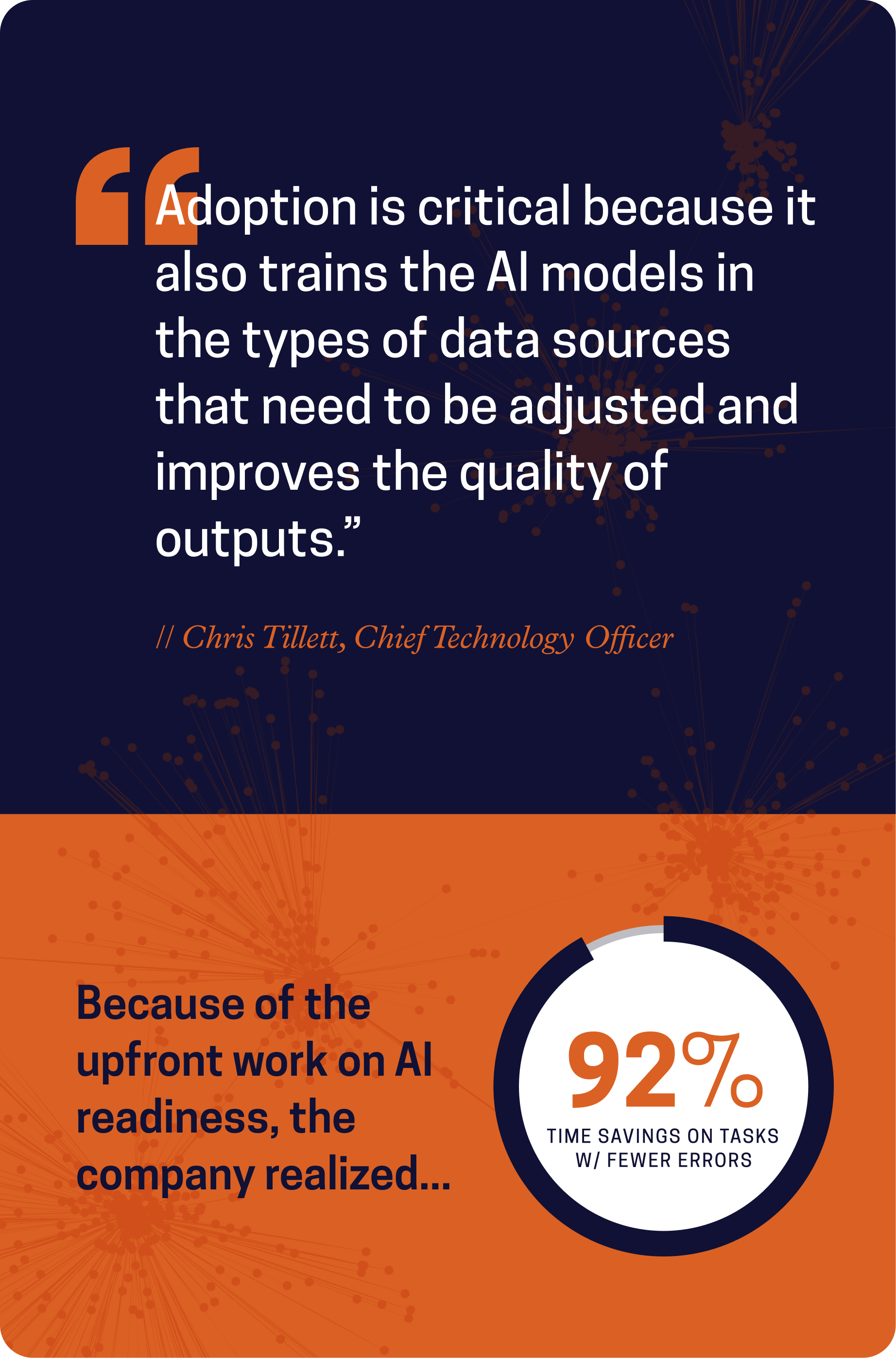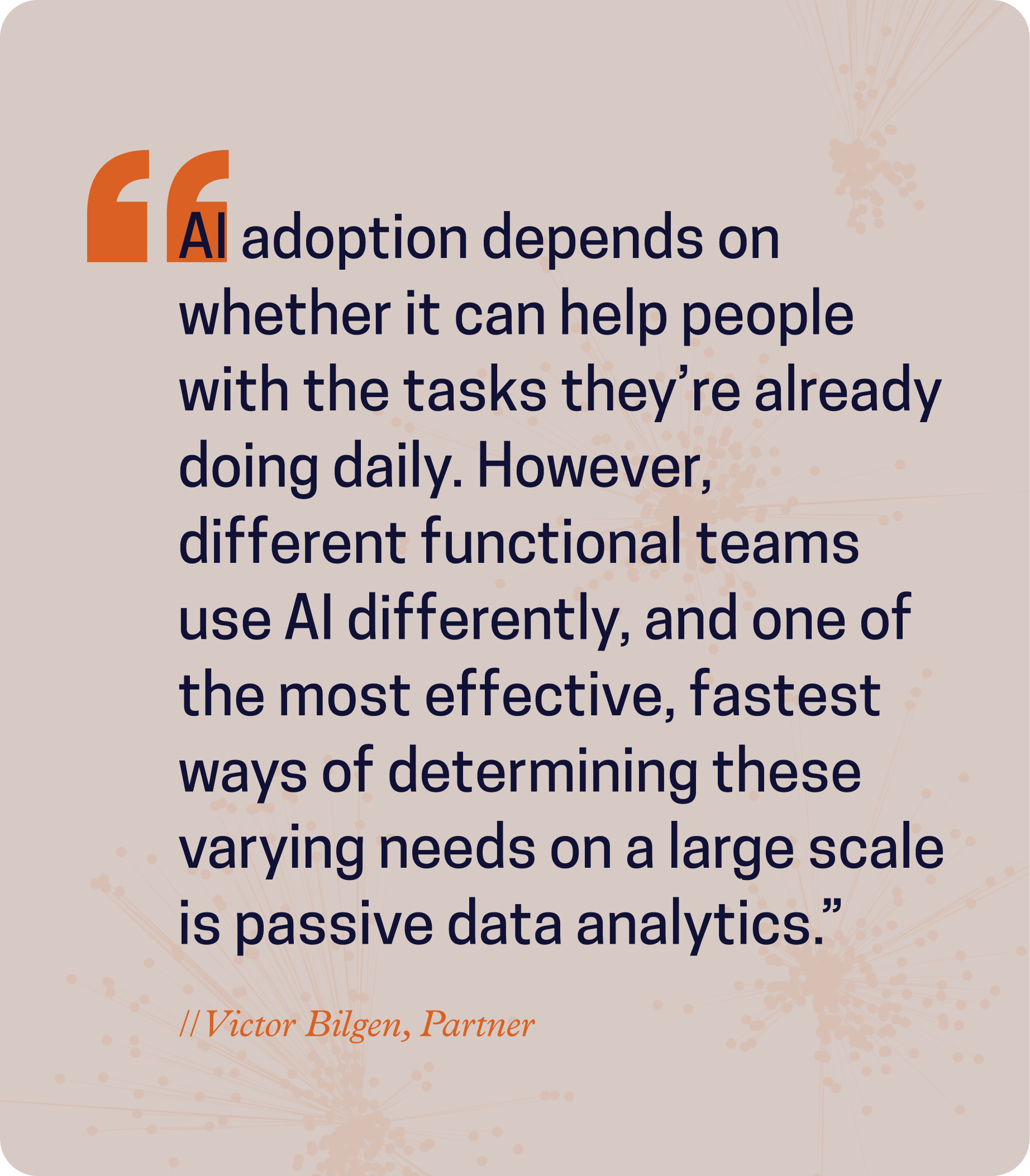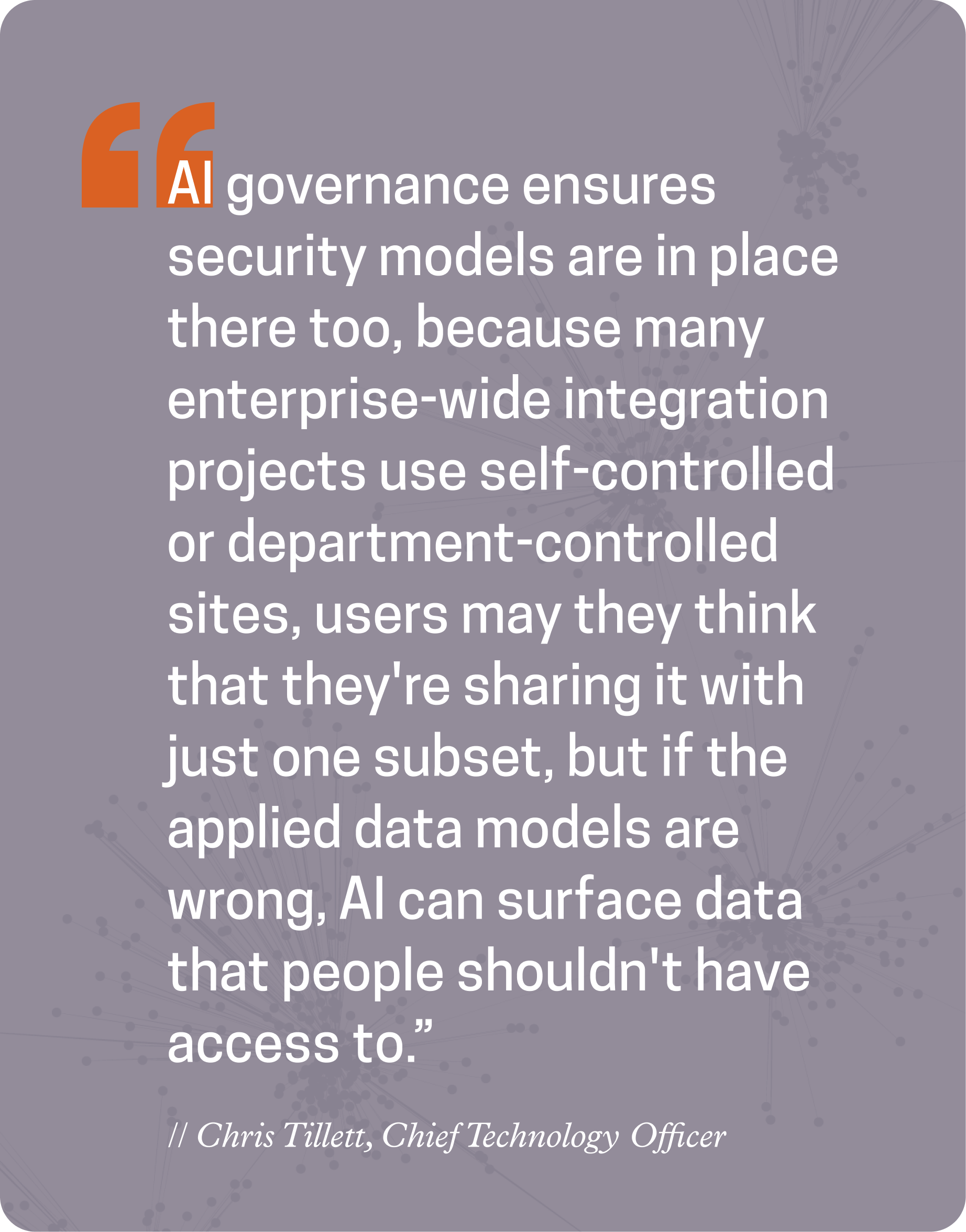There’s no question whether today’s organizations must integrate artificial intelligence (AI) into their workflows and operations for tomorrow’s challenges. If anyone is still debating the transformative power of AI, well, this article isn’t intended to convince them.
Instead, this piece serves to detail how organizations who believe in the impact of AI and the potential it has to tap into their team’s potential to integrate it effectively so no one is left behind.
To truly understand the scope of this shift, one must only follow the money. Organizations will invest significant capital over the next several years in AI integration. A Gartner study found that nearly 70 percent of finance leaders will fund initial research, experimentation, or AI integration into business operations.
However, AI is different than other technologies. AI learns and can act autonomously, and it responds based on the value of its human interactions and the quality of accessible data. As companies and government agencies place big bets on AI, a deliberate and strategic approach is vital to realize those investments. AI integration is not cheap, and tech giants are expected to spend over $1 trillion on AI in the coming years, according to Goldman Sachs. The successful integration of AI cannot be left to chance when taking into consideration its price tag, possible security and privacy concerns, and benefits to business outcomes. Organizations must ensure operational readiness before embarking on AI integration at scale.
What is AI Readiness?
We have seen firsthand how successful integration of AI can transform business operations. We’ve helped numerous public and private sector organizations across various industries achieve AI readiness so they can adopt, integrate, and build value from AI initiatives. Companies can’t just “turn on” AI and hope it will transform their organization.

“Without that push down from the top level, we’re not seeing significant levels of adoption,” said Chris Tillett, McChrystal Group’s Chief Technology Officer, who’s helped lead AI integration at leading consumer goods and biotech companies. “Adoption is critical because it also trains the AI models in the types of data sources that need to be adjusted and improves the quality of outputs.
Tillett recently led an effort at a Fortune 500 pharmaceutical company to improve competitor analysis and save valuable manpower. As part of the project, Tillett and his team partnered with the organization to conduct a comprehensive analysis to ensure the model had the correct data and the users had appropriate training to achieve the desired outcome. Because of the upfront work on AI readiness, the company realized a 92 percent time savings on the task with fewer errors. Just imagine what your team can accomplish with that much time saved.
This success underscores a core principle of AI integration: readiness depends on building shared consciousness and common purpose across teams. Shared consciousness ensures all stakeholders—from senior leaders to frontline users—understand what AI can and cannot do, what data it requires, and how it aligns with the broader strategy. A clearly defined common purpose provides direction, enabling users to apply the technology toward meaningful goals, accelerating adoption and impact.
What is an AI Integration Strategy?
A structured integration process is one of the most successful ways to improve employee adoption of AI tools and maximize return on investment. Leaders must think of AI as more than just a tool to do a job; it’s a tool that will change how a job is done. This requires assessing current workflows, organizational collaboration trends, and knowledge management systems to determine where AI may have the most significant impact. Then, organizations must build systems to develop and grow employees who will use AI during their day-to-day activities.
An effective AI integration strategy must focus on three areas critical to the tool's adoption and successful utilization. First, organizations must leverage data and process review to measure AI’s potential impact and track its uses after integration. McChrystal Group has developed a system to track AI integration in real time to measure adoption, impact, maturity, and culture. Leaders should also ensure any AI Integration Strategy maps back organizational values, missions, and strategic objectives. Next, leaders must establish cross-functional governance systems that set the policies, develop the processes, and capture lessons learned from AI integration efforts.
Finally, companies need agile and iterative training practices to prepare their employees for a new way of working. This approach establishes organizational intelligence to experiment with, integrate, and operate artificial intelligence systems. An AI integration strategy must also align with the organization’s goals, strategies, value systems, and industry-specific regulations or laws.
Leveraging Data to Measure AI Impact & Drive Adoption

An effective AI integration strategy starts with understanding organizational needs, processes, and collaboration patterns to discern where AI applications will most impact outcomes. Most leaders know they need to use machine learning or other forms of AI in their business, but they don’t know where to start. That’s where data collection and analysis can make or break AI initiatives
How Can Data Inform AI Implementation?
McChrystal Group uses several streams of organizational data to understand workflows, network collaboration, and document telemetry to determine tasks that would most benefit from AI. Solutions architects recently conducted passive data analysis for a global consumer goods company using Microsoft’s suite of employee engagement and knowledge management products. McChrystal Group mapped the teams' collaboration and workflow, used document telemetry to identify time-consuming tasks, and tailored recommendations based on unique adoption curves and barriers revealed in the passive data analysis.

“AI adoption depends on whether it can help people with the tasks they’re already doing daily,” said Victor Bilgen, a partner at McChrystal Group who has led AI enablement projects with several organizations. “However, different functional teams use AI differently, and one of the most effective, fastest ways of determining these varying needs on a large scale is passive data analytics.”
Data collection helps reveal needs and use cases that can remove the mundanity of work, lead to more engaged employees, and help organizations think more broadly and move more quickly on any AI innovation, according to Bilgen.
This foundational step – defining a clear problem statement, use case, or objective – is critical for successful AI integration.
Sustainable integration also depends on a trust-based network where employees feel safe sharing feedback and see their input shaping how AI evolves within the organization. Acting on this feedback builds the trust necessary for long-term adoption, reinforcing that their data is respected and their insights matter.
What are the Steps of AI Implementation?
An AI integration strategy helps map potential use cases for implementation and AI enablement using passive data, surveys, working groups, and process reviews.
In many cases, leaders may have a process or function they’d like to enable with AI; however, they may not know where to start or how to ensure adoption of the new process. AI integration has eight distinct steps that lead to successful process enablement.
AI Integration Steps:
- Identify Problem or Objective: Clearly define the business challenge or opportunity that AI can address. This forms the foundation for aligning AI initiatives with organizational goals.
- Assess Data and Employee Readiness: Evaluate the quality of existing data and gauge employee preparedness to adopt AI. This ensures that the organization is equipped for a smooth AI transition.
- Choose the Right Tool and Technology: Select AI tools and technologies that best fit the identified needs and objectives, considering scalability and integration capabilities.
- Integrate AI into Processes: Embed AI tools into workflows to complement existing operations, ensuring seamless interaction with human inputs.
- Test and Validate AI Solutions: Conduct rigorous testing of AI models to verify their performance, accuracy, and compatibility with organizational requirements.
- Deploy AI Solutions: Roll out the AI solutions across the relevant areas of the organization, ensuring that they are accessible and user-friendly for the employees.
- Scale and Expand: Once initial deployment is successful, scale AI usage across other functions or departments to maximize impact.
- Ensure AI Governance and Policies: Implement governance structures and policies to oversee AI usage, focusing on compliance, ethical considerations, and continuous improvement.
Leveraging Data for AI Integration
To successfully integrate AI, organizations must first understand where the technology can drive the most value. Data plays a pivotal role in this process, offering insights that guide every step, from problem identification to scaling and governance. By leveraging a combination of data and human input, organizations can fine-tune their AI strategies to align with real-world needs and opportunities.
“If you don't actually have a reason for driving people towards AI, then you can't,” said Tillett. “Data is useful in developing an effective AI Integration strategy; however, it doesn’t always tell the whole story, which is why we look at several different sources to determine AI needs.”

Passive Data
Passive data provides an objective view of how employees collaborate and perform tasks. This data, captured through tools like Microsoft Viva Insights and document telemetry, reveals hidden inefficiencies, redundant processes, and potential AI use cases. For example, McChrystal Group helped a global consumer goods company analyze how different teams collaborated and identified areas where AI could save significant time, especially in document creation and review.
“We can extrapolate the average time it takes to create a document through telemetry and correlate reduced times to AI-enabled development and reviews,” said Bilgen.
Surveys & Employee Feedback
Surveys and employee feedback add a crucial layer of qualitative insight to passive data. They reveal how employees feel about their workflows, identify pain points, and highlight areas where AI might make their jobs easier. Employee engagement in this process also fosters early buy-in for AI adoption, making it easier to integrate AI solutions effectively. McChrystal Group also identifies pockets of highly collaborative employees to leverage early adopters.
“Executives and senior leaders tend to use the AI differently than mid-level or frontline employees, as they need to consolidate more diverse sources of information,” said Bilgen. “Even simple survey questions can be invaluable for capturing the effectiveness or unearthing needs for AI enablement.”
Bilgen used an AI implementation project with a major pharmaceutical company that simply used Microsoft Forms to survey employees on which AI initiatives were working and which processes were most impacted by its use. The team entered any time savings into the form, which gave leaders an understanding of where the integration project was working and where it wasn’t.
Process Mapping
Finally, process mapping is essential for evaluating current workflows and understanding how AI can improve them. They ensure that AI integration is aligned with existing business processes and that the tools chosen will deliver tangible improvements. Combining these data streams allows organizations to identify where AI can have the greatest impact and ensure the workforce is prepared and aligned for the change.
This holistic approach to data informs each step in the AI integration process, from defining the problem to ensuring long-term governance and scalability. By taking a data-driven approach, organizations can strategically deploy AI to optimize human and technological resources.
Establishing Centers for Cross-Functional AI Governance
As organizations advance in their AI integration efforts, successful implementation requires more than just the right tools and technologies—it demands a structured governance framework. A cross-functional governance board is essential to ensure AI initiatives are aligned with broader business goals, mitigate risks, and drive enterprise-wide AI enablement. At McChrystal Group, we have seen firsthand the critical role these Centers of Excellence play in overseeing AI initiatives, fostering collaboration, and ensuring accountability across departments.
Managing Enterprise-wide AI Enablement
AI touches every aspect of the organization – from marketing and HR to IT and legal, and AI initiatives often span different departments, each with unique needs and objectives. This creates a complex environment where multiple AI solutions may be deployed simultaneously, making it critical to have a governance board to manage these varied initiatives under a unified strategy. Cross-functional governance helps organizations coordinate these efforts, ensuring alignment between departments and reducing redundancy.

“IT departments need help understanding what is needed to get AI implementation right,” said Bilgen. “Instead of just having one person or department owning it, cross-functional teams create a much more agile deciding body on overarching governance, compliance licensors, investment impact, and other big cross-functional problems.”
Reducing Risk and Ensuring Ethical AI Practices
Moreover, these centers for AI governance develop and enforce governance policies and procedures that manage risks such as data privacy, security, and ethical AI use. One McChrystal Group client reported that an employee unintentionally accessed private information through an AI solution. This occurred because an AI governance framework wasn’t fully established, leaving the organization vulnerable. The team implemented a cross-functional governance structure that ensures that such risks are mitigated by setting clear guidelines for data use, implementing secure AI solutions, and fostering compliance with industry-specific regulations.

“AI governance ensures security models are in place there too,” said Tillett. “Because many enterprise-wide integration projects use self-controlled or department-controlled sites, users may they think that they're sharing it with just one subset, but if the applied data models are wrong, AI can surface data that people shouldn't have access to.”
A critical example of this is the biopharma industry, which is using AI to shorten the research curve on lifesaving drugs. However, these AI tools need strict safety mechanisms to limit access due to fraud concerns or, worse, prevent the weaponization of biotechnology.
Scaling AI Solutions Enterprise-Wide
Finally, cross-functional centers of excellence enable organizations to scale AI solutions while managing the long-term sustainability of AI systems. By continually monitoring AI performance, capturing lessons learned, and adjusting governance policies as needed, these boards ensure that AI is used effectively across the enterprise. They also promote a culture of shared responsibility and collaboration, where AI enablement is viewed not as an IT initiative but as a company-wide effort, adequately resourced and deliberately executed. This strategic oversight is the cornerstone of driving enterprise-wide AI integration while ensuring that risks are minimized and outcomes are maximized.
Agile and Iterative Training for an AI Enablement
With cross-functional governance frameworks in place to ensure alignment, compliance, and risk mitigation, the next critical step in AI integration is preparing the workforce to adapt to this transformative technology. Governance alone cannot drive success – effective training is essential to ensure that AI solutions are adopted at every level of the organization and that employees are equipped to work alongside AI, not around it. This is where agile and iterative training becomes indispensable, ensuring that employees remain at the forefront of AI adoption and the organization maximizes its investment in these tools.
Building an AI-Ready Workforce
The integration of AI fundamentally changes how work is done, and employees must be ready to embrace this shift. AI is not a static tool; it evolves and requires continuous learning. Just as AI models learn from data and human interactions, employees must continually develop the skills to use these technologies effectively. Just like a Team of Teams, AI training should follow an iterative cadence: adaptable, feedback-driven, and always aligned to the evolving reality of work.
“You need to ensure the readiness of your workforce,” said Bilgen. “One of the most basic AI skills is writing good prompts; however, AI doesn’t understand inflection, implied social context, and other human traits. Despite having the ability to process and structure massive amounts of data, if you ask AI crappy questions, you get crappy answers.”
Because of this, AI adoption falters without proper training, leading to frustration, lower productivity, and potentially costly setbacks. Employees unprepared for AI integration may struggle to adapt to new workflows, undermining the technology's potential to streamline processes and drive efficiency. In the worst-case scenario, inadequate training can result in costly errors or delays, eroding the gains AI is supposed to deliver.
The Role of Human Inputs in AI and Organizational Success
Effective training ensures that employees can use AI to its fullest potential, and human inputs also play a pivotal role in training the AI itself. The quality of the data provided by employees and their interactions with AI systems directly impacts the accuracy and effectiveness of AI outputs. This relationship between human inputs and AI systems underscores the need for an informed and engaged workforce. Properly trained employees provide more reliable data, interact more meaningfully with AI tools, and ultimately help improve the system’s overall functionality. As such, training must focus on operational knowledge and the importance of human input in refining AI models.
“If you're not pushing people to learn or capturing best practices, you're not going to see AI take off,” said Tillett. “The moment organizations begin to integrate formal training processes for AI is the moment it will start to truly take off.”
McChrystal Group facilitated an AI training program for more than 60,000 employees at a biopharma company, and adoption rates went up significantly. However, this engagement has to be sustained. If people stop talking about and iterating on how to leverage AI meaningfully, usage will drop significantly, which is another outcome we’ve seen in our integration projects.
Informing Agile and Iterative AI Training
Cross-functional centers for AI governance are pivotal in shaping and informing iterative training programs. These governance bodies provide a comprehensive view of the organization’s AI initiatives, ensuring that training is tailored to the diverse needs of various departments and levels of AI users. As AI enablement often requires distinct approaches across different business units, governance boards identify key AI goals, assess user readiness, and determine the training needs for different functional areas. This structured oversight allows the organization to align AI training programs with real-world use cases and operational needs, making the transition to AI-enabled workflows smoother and more effective.
Varying Levels of AI Users and Systems in Driving AI Integration
The varying levels of AI users – ranging from data scientists and technical experts to front-line employees – necessitate customized training programs. For instance, while IT teams may need deep technical knowledge to manage AI systems, non-technical employees may only require training to integrate AI into daily tasks. Cross-functional governance helps ensure that training is adaptable and relevant, accounting for these differing levels of expertise. By aligning training initiatives with governance strategies, organizations can ensure that each team has the necessary skills and understanding to contribute to AI’s success across the enterprise.
“AI adoption rates within organizations really comes down to training; however, it has to be relevant, said Tillett. “That’s why learning paths for each of these different components and levels are vital to embedding behaviors that result in lasting change to workflow, which take about 90 days for to take hold.”
Embracing AI for Tomorrow’s Success

AI integration isn't just a tech challenge—it’s a human one. Success depends on breaking down silos, empowering frontline teams, sharing context across functions, and operating with disciplined adaptability. The Team of Teams model provides a battle-tested framework to lead in this complex, fast-evolving space. AI won’t replace teams, but the best teams will know how to leverage and adapt to AI.
AI is revolutionizing how organizations operate, offering unprecedented opportunities for innovation, efficiency, and competitive advantage. However, realizing these benefits requires more than just investing in tools. It demands a deliberate, strategic approach—grounded in data-driven decision-making, comprehensive governance, and a deep commitment to workforce readiness.
At McChrystal Group, our experience across industries shows that AI readiness is built through aligning initiatives to strategic goals, fostering cross-functional collaboration, and deploying agile, iterative training that equips employees for the future of work.
Organizations that approach AI integration as a system-wide optimization—by harnessing data, establishing governance frameworks, and investing in people—position themselves not only to adopt AI effectively but also to thrive with it.
The journey to AI enablement may seem daunting, but with the right strategy, it can become a catalyst for transformation and long-term success.
Are you ready to explore how AI can revolutionize your organization?
The experts at McChrystal Group are here to help. Our team of AI integration specialists can guide you through every step of the process—from assessing your AI readiness to developing a tailored strategy for seamless integration. Contact us today to discuss how we can help your organization unlock the full potential of AI and drive impactful results. Let’s get started on your AI journey.



